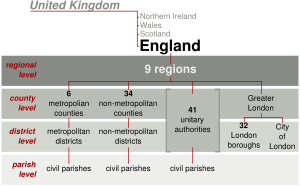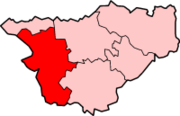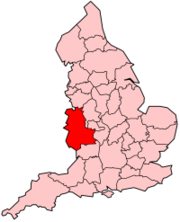Local government in England
2008/9 Schools Wikipedia Selection. Related subjects: UK Politics & government
The pattern of local government in England is complex, with the distribution of functions varying according to the local arrangements. Unlike the other three constituent countries of the United Kingdom, England has no single, separate devolved English parliament other than that of the Government of the United Kingdom.
Subdivisions
Principal authorities
England is subdivided into 9 regions. One of these, London, has an elected Assembly and Mayor, but the others have a relatively minor role, with unelected regional assemblies and Regional Development Agencies. Below the region level and excluding London, England has two different patterns of local government in use. In some areas there is a county council responsible for services such as education, waste management and strategic planning within a county, with several district councils responsible for services such as housing, waste collection and local planning. These councils are elected in separate elections. Some areas have only one level of local government, and these are dubbed unitary authorities.
Parishes and communities
Below the district level, a district may be divided into several civil parishes. Typical activities undertaken by a parish council include allotments, parks, public clocks, and entering Britain in Bloom. They also have a consultative role in planning. Councils such as districts, counties and unitaries are known as principal local authorities in order to differentiate them in their legal status from parish and town councils, which are not uniform in their existence. Local councils tend not to exist in metropolitan areas but there is nothing to stop their establishment. For example, Birmingham has a parish, New Frankley. Parishes have not existed in Greater London since 1965, but from 2007 can legally be created. In some districts, the rural area is parished and the urban is not - such as in the borough of Shrewsbury and Atcham, where the town of Shrewsbury is unparished and has no local councils, while the countryside around the town is parished. In others, there is a more complex mixture, as in the case of Crewe and Nantwich, where Nantwich is parished, Crewe is not, and many parishes share a parish council with neighbouring parishes.
History
The current arrangement of local government in England is not the result of a single comprehensive policy, but a range of incremental measures which have their origins in the municipal reform of the 19th century. During the 20th century the structure of local government was reformed and rationalised, with local government areas becoming fewer and larger; and the functions of local councils amended. The way local autorities are funded has also been subject to periodic and significant reform.
People
Councillors and mayors
Councils have historically had no split between executive or legislature. Functions are vested in the council itself, and then exercised usually by committees or subcommittees of the council. The post of leader was recognised, and leaders typically chair several important committees, but had no special authority. The chair of the council itself is an honorary position with no real power. Under section 15 the Local Government and Housing Act 1989, committees must roughly reflect the political party makeup of the council; before it was permitted for a party with control of the council to 'pack' committees with their own members. This pattern was based on that established for municipal boroughs by the Municipal Corporations Act 1835, and then later adopted for county councils and rural districts.
In 2000 Parliament passed the Local Government Act 2000 to require councils to move to an executive-based system, either with the council leader and a cabinet acting as an executive authority, or with a directly-elected mayor, either with a mayor and cabinet drawn from the councillors; or a mayor and council manager. There is a small exception to this whereby smaller district councils (population of less than 80,000) can adopt a modified committee system. Most councils are using the council leader and cabinet option, whilst 52 smaller councils have been allowed to propose alternative arrangements based on the older system (Section 31 of the Act), and Brighton and Hove invoked a similar provision (Section 27(2)(b)) when a referendum to move to a directly-elected mayor was defeated.
There are now twelve directly-elected mayors, in districts where a referendum was in favour of them. Many of the mayors are independents (notably in Hartlepool and Middlesbrough, which in parliamentary elections are usually Labour Party strongholds). Since May 2002 only a handful of referendums have been held, and they have all been negative apart from Torbay. Of the mayors, all but Stoke-on-Trent's are mayor and cabinet-based. The Executive, in whichever form, is held to account by the remainder of the Councillors acting as the ' Overview and Scrutiny function' - calling the Executive to account for their actions and to justify their future plans. As a relatively new concept within local government, this is arguably an under-developed part of local municipal administration. In a related development, the Health and Social Care Act 2001, Police and Justice Act 2006, and 2006 local government white paper set out a role for local government Overview and Scrutiny in creating greater local accountability for a range of public sector organisations.
Boroughs in many cases are descendants of municipal boroughs set up hundreds of years ago, and so have accreted a number of traditions and ceremonial functions. Wherer borough councils have not adopted a directly-elected mayor, the chair of the council is the mayor. In certain cities the mayor is known as the Lord Mayor. Councils may make people honorary freemen or honorary aldermen.
Elections
The area which a council covers is divided into one or more electoral divisions - known in district and parish councils as ' wards', and in county councils as 'electoral divisions'. Each ward can return one or more members - multi-member wards are quite common. There is no requirement for the size of wards to be the same within a district, so one ward can return one member and another ward can return two. Metropolitan borough wards must return a multiple of three councillors, whilst until the Local Government Act 2003 multiple-member county electoral divisions were forbidden.
In the election, the candidates to receive the most votes win – the multi-member plurality system. There is no element of proportional representation, so if four candidates from the Mauve Party poll 2,000 votes each, and four candidates from the Taupe Party poll 1,750 votes each, all four Mauve candidates will be returned, and no Taupe candidates will. Although this has been said by some to be undemocratic, minor and local single-issue parties do tend to do much better at local elections than they do in general elections, so the case for reform is perhaps less clear. In any event, the system is not likely to change for the foreseeable future.
The term of a councillor is usually four years. Councils may be elected wholly, every four years, or 'by thirds', where a third of the councillors get elected each year, with one year with no elections. Recently the 'by halves' system, whereby half of the council is elected every two years, has been allowed. Sometimes wholesale boundary revisions will mean the entire council will be re-elected, before returning to the previous elections by thirds or by halves over the coming years.
Officers
Councillors cannot do the work of the council themselves, and so are responsible for appointment and oversight of officers, who are delegated to perform most tasks. Local authorities nowadays have to appoint a 'Chief Executive Officer', with overall responsibility for council employees, and who operates in conjunction with department heads. The Chief Executive Officer position is weak compared to the council manager system seen in other countries (and in Stoke). In some areas, much of the work previously undertaken directly by council employees has been privatised.
Functions and powers
| Arrangement | Upper tier authority | Lower tier authority |
|---|---|---|
| Shire counties | waste management, education, libraries, social services, transport, strategic planning, consumer protection | housing, waste collection, council tax collection, local planning, licensing, cemeteries and crematoria |
| Unitary authorities |
housing, waste management, waste collection, council tax collection, education, libraries, social services, transport, planning, consumer protection, licensing, cemeteries and crematoria † | |
| Metropolitan counties | housing, waste collection, council tax collection, education, libraries, social services, transport, planning, consumer protection, licensing, cemeteries and crematoria † | |
| Greater London | transport, strategic planning, regional development, police, fire | housing, waste collection, council tax collection, education, libraries, social services, local planning, consumer protection, licensing, cemeteries and crematoria † |
† = in practice, some functions take place at a strategic level through joint boards and arrangements
Councils also have a general power to 'promote economic, social and environmental well-being' of their area. However, like all public bodies, they are limited by the doctrine of ultra vires, and may only do things that common law or an Act of Parliament specifically or generally allows for - in contrast to the earlier incorporated municipal corporations which were treated as natural persons and could undertake whatever activities they wished to. Councils may promote Local Acts in Parliament to grant them special powers. For example, Kingston upon Hull, had for many years a municipally-owned telephone company, Kingston Communications.
Funding
Local councils are funded by a combination of central government grants, Council Tax (a locally set tax based on house value), Business Rates, and fees and charges from certain services including decriminalised parking enforcement. The proportion of revenue that comes from Council Tax is low, meaning that if a council wishes to increase its funding modestly, it has to put up Council Tax by a large amount. Central government retains the right to 'cap' Council Tax if it deems it to be too much. This is an area of debate in British politics at the moment, with councils and central government blaming each other for council tax rises.
Council Tax is collected by the district-level council. Authorities such as the GLA, parish councils, county councils, passenger transport authorities, fire authorities, police authorities, and national parks authorities can make a precept. This shows up as an independent element on council tax bills, but is collected by the district and funnelled to the precepting authority. Some joint ventures are instead funded by levy.
Boundaries and names
Sizes of council areas vary widely. The most populated district in England is Birmingham (a metropolitan borough) with 977,087 people (2001 census), and the least populated non-metropolitan unitary area is Rutland with 34,563. However, these are outliers, and most English unitary authorities have a population in the range 150,000 to 300,000. The smallest non-unitary district in England is Teesdale at 24,457 people, and the largest Northampton at 194,458. All but 9 non-unitary English districts have less than 150,000, though. Responsibility for minor revisions to local government areas falls to the Boundary Committee for England Revisions are usually undertaken to avoid borders straddling new development, to bring them back into line with a diverted watercourse, or to align them with roads or other features.
Where a district is coterminous with a town, the name is an easy choice to make. In some cases, a district is named after its main town, despite there being other towns in the district. Confusingly, such districts sometimes have city status, and so for example the City of Canterbury contains several towns apart from Canterbury, which have distinct identities. Similarly Chester contains a number of large villages and extensive countryside, which is quite distinct from the main settlement of Chester. They can be named after traditional subdivisions ( Spelthorne), rivers ( Eden, Arun), a modified version of their main town's name ( Harborough, Wycombe), or after a geographical feature in the district ( Cotswold, Cannock Chase). Purely geographical names can also be used ( South Bucks, Suffolk Coastal, North West Leicestershire). Councils have a general power to change the name of the district, and consequently their own name, under section 74 of the Local Government Act 1972. Such a resolution must have two thirds of the votes at a meeting convened for the purpose.
Councils of counties are called 'X County Council', whereas district councils can be District Council, Borough Council, or City Council depending upon the status of the district. Unitary authorities may be called County Councils, Borough Councils, City Councils, District Councils, or sometimes just Councils. These names do not change the role or authority of the council. London is further divided into 32 London boroughs, each goverened by a London Borough Council and the City of London which is governed by the City of London Corporation. Metropolitan counties have no county councils and are divided into metropolitan districts whose councils have either the status of City Council or Metropolitan Borough Council. Some districts are Royal boroughs, but this does not affect the name of the council.
Special arrangements
Joint arrangements
Local authorities sometimes provide services on a joint basis with other authorities, through bodies known as joint-boards. Joint-boards are not directly elected but are made up of councillors appointed from the authorities which are covered by the service. Typically joint-boards are created to avoid splitting up certain services when unitary authorities are created, or a county or regional council is abolished. In other cases, if several authorities are considered too small (either in terms of geographic size or population) to run a service effectively by themselves, joint-boards are established. Typical services run by joint-boards include policing, fire services, public transport and sometimes waste disposal authorities.
If a county is too small to justify its own police force, a joint police force is used which covers several counties, for example the West Mercia Constabulary covers Shropshire, Telford and Wrekin, Herefordshire and Worcestershire. In the six metropolitan counties the metropolitan borough councils, also appoint members to joint county-wide Passenger Transport Authorities to oversee public transport, and joint waste disposal authorities, which were created after the county councils were abolished.
Joint-boards were used extensively in Greater London when the Greater London Council was abolished, to avoid splitting up some London wide services. These functions have now been taken over by the Greater London Authority. Similar arrangements exist in Berkshire where the county council was abolished. If a joint body is legally required to exist it is known as a joint-board. However local authorities sometimes create joint bodies voluntarily and these are known as joint-committees.
Corporation of London
The City of London covers a square mile (2.6 km²) in the heart of London. It is governed by the Corporation of London, which has a unique structure. The Corporation has been broadly untouched by local government reforms and democratisation. The business vote was abolished for other parts of the country in 1969, but due to the low resident population of the City this was thought impractical. In fact, the business vote was recently extended in the City to cover more companies.
Future
The Government released a Local Government White Paper on 26 October 2006, Strong and Prosperous Communities, which deals with the structure of local government. The White Paper does not deal with the issues of local government funding or of reform or replacement of the Council Tax, which is awaiting the final report of the Lyons Review. A Local Government Bill has been introduced in the 2006-2007 session of Parliament. The White Paper emphasises the concept of "double devolution", with more powers being granted to councils, and powers being devolved from town halls to community levels. It proposes to reduce the level of central government oversight over local authorities; by removing centrally-set performance targets, and statutory controls of the Secretary of State over parish councils, bye-laws, and electoral arrangements.
The white paper proposed that the existing prohibition on parish councils in Greater London will be abolished, and making new parishes easier to set up. Parish councils can currently be styled parish councils, town councils or city councils: the White Paper proposes that "community council", "neighbourhood council" and "village council" may be used as well. The White Paper proposes to strengthen the council executives, and provides an option between a directly-elected mayor; a directly-elected executive; or an indirectly elected leader; with a fixed 4-year term. It promises that the Department for Transport will put forward proposals for a reform of the Passenger Transport Authorities. The white paper allows for structural changes to local government in England and consensus-based proposals for unitary authority status, were asked to be submitted before 25 January 2007.
A report released by the IPPR's Centre for Cities in February 2006, City Leadership: giving city regions the power to grow, proposed the creation of two large city-regions based on Manchester and Birmingham : the Birmingham one would cover the existing West Midlands metropolitan county, along with Bromsgrove, Cannock Chase, Lichfield, North Warwickshire, Redditch and Tamworth, whilst the Manchester one would cover the existing Greater Manchester along with the borough of Macclesfield. No firm proposals of this sort appear in the White Paper. Reportedly, this had been the subject of an internal dispute within the government.



